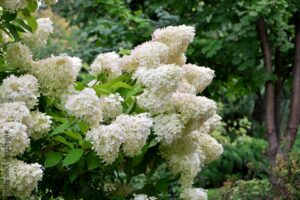
Hydrangeas are an increasingly popular group of shrubs which are prized for their flowers. Ornamental growers produce numerous varieties for the landscape, as well as, holiday florist markets. Increasing the number of branches has potential for increasing blooms and a more desirable crop. Identifying a plant growth regulator treatment that effectively improves the architecture of hydrangeas became a research priority for the IR-4 Program in 2010. Research evaluating Augeo (dikegulac sodium), Configure (benzladenine) and Florel (ethephon) shows promising results. Augeo (800 and 1600 ppm) significantly increased branching compared to untreated pots of florist varieties Hydrangea macrophylla ‘Merritt’s Supreme’ and landscape varieties H. macrophylla ‘Nikko Blue’ and H. paniculata ‘Limelight’. Configure (300 ppm and 600 ppm) was not effective in improving branching on H. macrophylla. In a single experiment Configure increased branch count on H. paniculata. Inconsistent results were observed with Florel treatments at 500 and 1000 ppm with three out of five experiments not impacting branching. Hydrangea paniculata responded to 1000 ppm Florel with improved branching. Significant chlorosis on Augeo treated plants was observed initially but this diminished by 6 WAT. Little to no crop injury was observed with Configure or Florel treatments to hydrangea liners. This research shows promise for identifying a plant growth regulator treatment(s) to meet the demand for improved branching on hydrangea.


